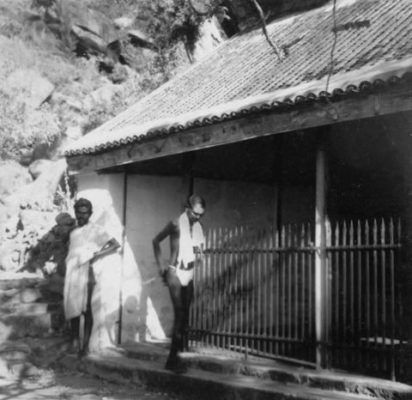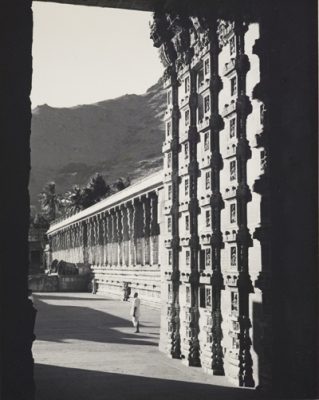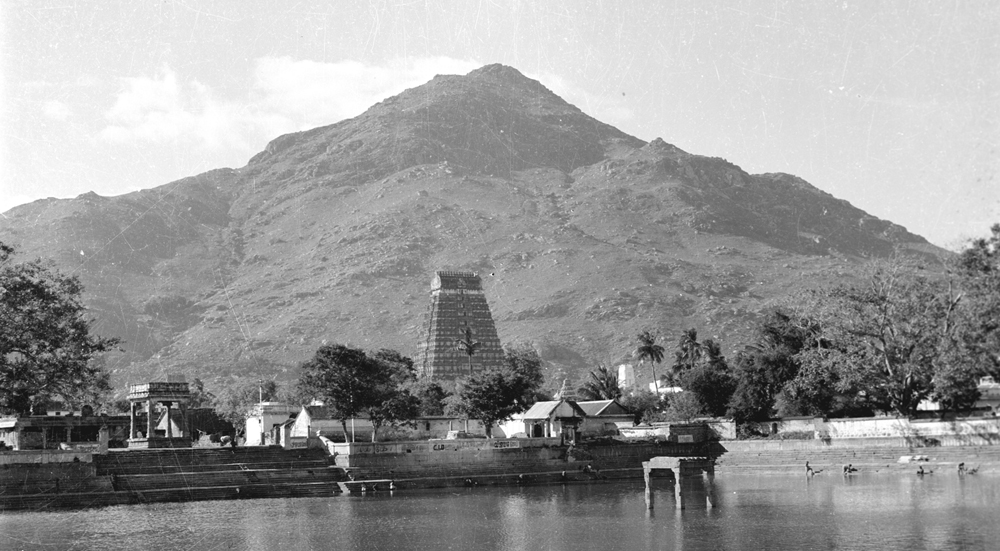
Introduction
Guhai Namasivaya was a Saiva poet-saint who came to Tiruvannamalai in either the late 15th or the early 16th century and then spent most of the remainder of his life living in a cave on Arunachala that still bears his name. His title ‘Guhai’ is the Tamil word for a cave.
Part of this narrative has been taken from an article that first appeared in The Mountain Path, 1990, pp. 115-23. The material first published there was primarily a translation of the introductory biography that appeared in 1967 Tamil Tanjore Saraswati Mahal Library edition of Arunagiri Antadi. This was supplemented by explanatory notes on the nature of Virasaivism and translations of some of Guhai Namasivaya’s verses. I have subsequently added the contents of a new source on Guhai Namasivaya’s life that surfaced after the initial article was written. This combined edited account will appear as a chapter in a forthcoming book about Guhai Namasivaya and Guru Namasivaya.
The information about his life that has survived is highly hagiographical. The first attempt to chronicle his life was a Tamil biography, Guhai Namasivaya Leelai, composed about 1700 AD by Velaiyer Swami, one of the co-authors of the Kalatti Puranam. This work seems to have disappeared completely. Since none of the more recent accounts of his life refer to this biography, it is not possible to tell whether they derive their information from it, or whether they have tapped into other sources.
The oldest published account of his life appears in the Pulavar Puranam, a 19th century anthology of the lives of distinguished Tamil spiritual authors. Both Guhai Namasivaya and his most well-known disciple, Guru Namasivaya, had their lives chronicled in Tamil verse in this book.
There is one agreed date in the life of Guhai Namasivaya: 1548 AD. Kamil Zvelebil in his Lexicon of Tamil Literature, associates the date with the poem Arunagiri Antadi, which suggests that a colophon of one of the palm-leaf manuscripts contains this date. The poem itself comprises 100 verses in praise of Arunachala. It is generally accepted that Guhai Namasivaya came to Tiruvannamalai as a young man and began composing poetry about the mountain of Arunachala shortly afterwards. This would indicate a birth date in the early decades of the 16th century. This is consistent with the death dates of his two known disciples, Guru Namasivaya and Arumuga Swami, both of whom passed away in the mid-to-late17th century.
Guhai Namasivaya: the traditional story
Guhai Namasivaya was born in Karnataka to a pious Virasaiva couple. His spiritual nature became evident at an early age: he was virtuous in his conduct, adept at his studies and evinced no attachment to worldly matters. Feeling a great longing to receive the grace of the Lord, he embarked at an early age upon a search that led him to Sivananda Desikar, a famous Virasaiva Guru who lived at Sri Sailam, a major pilgrimage centre in southern Andhra Pradesh. He became a disciple of this Guru and began to serve him with fervent and selfless devotion.
The origin of Virasaivism, an offshoot of Saivism, can be traced back to the twelfth century. Its philosophy has grown out of the twenty-eight Saiva Agamas and the writings of its early exponents. Virasaivas are also known as Lingayats on account of the immense importance they attach to their conception of the term ‘lingam’. For them, lingam is not merely a physical object, it is synonymous with chaitanya, or consciousness, and can be taken to be Siva himself. In their philosophy, the term lingam can be equated with the parabrahman of the Upanishads, but it has other connotations as well. It is the cosmic principle that is the source of the universe and, in its physical form, it is the visible symbol of the consciousness that exists in all beings. In addition, and this is particularly interesting in view of the years Guhai Namasivaya spent at Arunachala, it is often conceived of as a mass of light or a column of blazing fire. Worship of the lingam in all its forms is central to Virasaivism.
The goal of Virasaivas is the attainment of oneness with Siva. To reach this exalted state, Virasaivas believe that one must submit to and serve a Guru who has already attained that oneness. Thus, in the Virasaiva tradition, the Guru is given immense importance, for it is he alone who can initiate the disciple, purify him, and lead him to unity with Siva.
For a devout Virasaiva, the spiritual path begins when he approaches a competent Guru and asks him for initiation. Usually, the Guru will first test him for a year to see how serious his spiritual inclinations are. When the Guru is satisfied that the disciple’s desire is genuine, he agrees to initiate him and accept him as a disciple. The initiation given by the Guru activates the power of lingam in the three bodies, the causal, the subtle and the gross, and removes some or all of the taints or imperfections that reside in each of the three bodies. Virasaivas believe that these taints, called mala, prevent the disciple from becoming established in lingam, the Supreme Siva-consciousness.
In the prescribed initiation ceremony the Guru draws out the power of lingam from the heart of the devotee, establishes it in a physical lingam, which is called ishtalinga, presents it to the disciple and commands him to worship it as if were Siva himself. The handing over of the ishtalinga removes the taints (mala) that are attached to the physical body.
The Guru then commands the devotee to wear the ishtalinga on his body at all times and to worship it three times a day. The Guru also tells him that the linga must on no account be separated from the body since such a separation is equivalent of spiritual death. In the Virasaiva tradition, it is not permitted to worship Siva in any other form except that of the ishtalinga or the lingam installed over one’s Guru’s samadhi. Virasaivas are therefore forbidden from worshipping forms of Siva that have been installed in temples.
We can assume that Guhai Namasivaya underwent this initiation ceremony since it is a compulsory rite of passage for all Virasaivas. He probably went through it quite early in his life, for it was not uncommon for eight-year-olds to be initiated in this way.
Sivananda Desikar, Guhai Namasivaya’s Guru, was an adept in a Virasaiva yoga system known as Siva Yoga. When Sivananada Desikar noticed what a mature disciple Guhai Namasivaya was, he initiated him into its practices. From then on, Guhai Namasivaya alternated his time between physical service to the Guru and the practice of Siva yoga. In the course of time he too became an accomplished Siva yogi.
The goal of Siva yoga is to find Siva in everything and to discover the fundamental root of that immanent Siva manifestation in one’s heart. Though Siva Yoga has a strong bhakti component, it is primarily a variety of kundalini yoga. The Siva yogis aim to make contact with the power of the Lord. They believe that the contact finally takes place after the prana, rising through the sushumna, has passed through all the six chakras and moved on to the bramarandhra, located at the top of the head. Accomplished Siva yogis, at the time of their death, voluntarily send all their pranas out of their bodies through this brahmarandhra and merge into the all-pervading consciousness of Siva.
Guhai Namasivaya practised this system of yoga for many years. When he had thoroughly mastered it, Lord Mallikarjuna, the presiding deity of Sri Sailam, appeared to Guhai Namasivaya in a dream and commanded him to go to Arunachala and remain there as a Guru, giving teachings to mature disciples who approached him. When he related this dream to his Guru, Sivananada Desikar gave him his blessings and told him to carry out the order. Shortly afterwards, Guhai Namasivaya set out on horseback for Tiruvannamalai.

There is a tradition in Tiruvannamalai that Guhai Namasivaya was accompanied on his journey by Virupaksha Deva, the man who gave his name to Virupaksha Cave. Ramana Maharishi occasionally told his devotees that the two of them were Virasaivas who came from Karnataka to Tiruvannamalai at the same time. It is reported that both of them had served Sivananada Desikar for twelve years. Very little is known about the life of Virupaksha Deva except that he lived in Virupaksha Cave for a long time, and that when he died there his body transformed itself into vibhuti (sacred ash). That vibhuti is still kept in the cave and puja is done to it every day.
On his journey to Tiruvannamalai Guhai Namasivaya came one evening to a village where a wedding was in progress. The head of the house where the wedding was taking place greeted him respectfully, invited him into the house, gave him the place of honour and performed puja to him. At the conclusion of the puja everyone present received some vibhuti from the hand of Guhai Namasivaya. Shortly afterwards, the house was completely destroyed by a fire. Some people, associating the fire with Guhai Namasivaya’s visit, poured scorn on him by saying, ‘The ash given by this yogi has turned the house itself into ash’.
Guhai Namasivaya was deeply hurt by this taunt, not personally, but because of the ridicule to which the Lord’s vibhuti had been subjected. He therefore meditated on Siva and through His grace was able to restore the house to its former unburnt state. Subsequently, those in the village who had formerly reviled him began to praise and worship him as if he were Siva himself. Guhai Namasivaya, perturbed by all the fuss his visit had caused, then took a vow that wherever he went in future, he would never again stay in any house.

On reaching Tiruvannamalai he stuck to his vow and lived in public halls, temple flower gardens and occasionally in the surrounding forest. He devoted himself to the practice of Siva Yoga and became so accomplished in it that he was able to spend long periods in samadhi, immersed in his inner lingam. Each day he visited the entrance of the Arunachaleswara Temple but went no further because, as a Virasaiva, he was prohibited from worshipping there. It seems that Guhai Namasivaya either had a desire to worship in the temple, or felt that he would benefit by doing so, for each day he would gesture with his hands in the direction of the shrine and to say to himself, ‘Are you well without worshipping Him?’
There was a sadhu called Sivakkira Yogi who noticed that Guhai Namasivaya never went through the temple entrance, but merely made strange gestures there. He interpreted this strange behaviour as deliberate irreverence and decided to punish him by striking him on the back with his cane. Guhai Namasivaya made no attempt to retaliate, nor did he even reproach his attacker. He merely composed an extempore verse in Tamil to the effect that the Lord had struck him in order to drive out his evil propensities. When Sivakkira Yogi saw Guhai Namasivaya responding in such a humble way, he immediately realised that he had failed to recognise the latter’s greatness.
After this incident Guhai Namasivaya began to feel that it would be appropriate for him to enter the temple and worship there. While he was contemplating this breach with tradition, his Guru, Sivananda Desikar, unexpectedly appeared, surrounded by a retinue of his devotees. Guhai Namasivaya greeted him with great love and devotion. In return, Sivananda Desikar spoke to him in a friendly and intimate way. Then to Guhai Namsivaya’s surprise, his Guru entered the temple with his disciples, walked straight to the inner sanctum and began to worship Siva there. Guhai Namasivaya, who had accompanied his Guru into the temple, followed his Guru’s example. He threw himself full-length on the ground and, filled with ecstasy, mentally worshipped the image of Siva that was enshrined there. When he stood up he could see no sign either of his Guru or his fellow disciples, but when he looked at the lingam he had been worshipping, he saw only the form of his Guru. Two of his verses (282 and 127) refer to this epiphany. [The numbers refer to the layout of the verses in our forthcoming book.]
In the lingam of the sanctum sanctorum at Arunai,
which is the lingam for all directions,
the One whose feet devotees bow to and praise
stands perpetually revealed to my eyes as the Sadguru.Arunesan!
When You revealed to me
Your compassion-filled holy form
in the lingam within Arunai’s holy of holies,
I grasped and held the feet of the Guru
as the true reality.
No more will I approach Brahma and Yama.
Arunesan is the Lord of Arunai, an old name of both Tiruvannamalai and the mountain of Arunachala. Brahma is the god of creation, while Yama is the god of death. In saying that he will ‘No more … approach Brahma and Yama’ Guhai Namasivaya is indicating that the experience liberated him from birth and death.
Guhai Namasivaya, realising that the appearance of his Guru had been the play of the Lord, interpreted his vision to mean that he now had permission to enter the temple and worship there. In Virasaivism, the authority of the Guru is paramount. If the Guru sanctions a practice, it immediately becomes acceptable even if it contravenes traditional rules and regulations.

After this incident Guhai Namasivaya decided to take up residence in the entrance to the temple. Each day he was there, he composed a verse in praise of Arunachala-Siva and put together a flower garland. He would then offer both of them to the lingam of Lord Siva in the inner shrine. In verse 456 he described the joy he took in these activities:
The world praises Lord Sonachala.
The desire of this dog is a thousand eyes
to keep Him ever in my sight,
adorning Him with flower garlands,
garlanding Him with verses, many times over,
and singing His holy name to a thousand tunes.
Sonachala, meaning ‘Red Mountain’, is another ancient name for Arunachala.